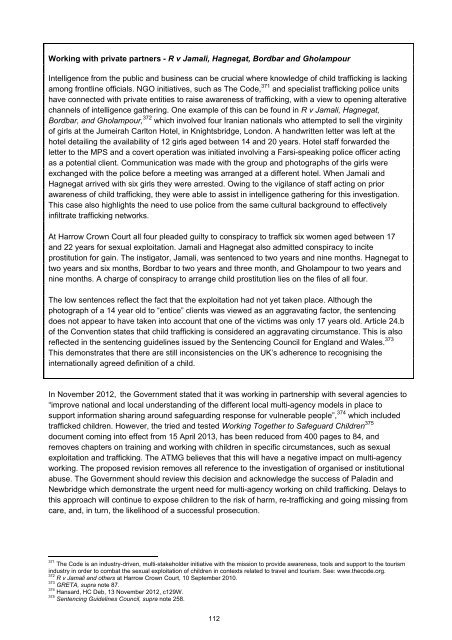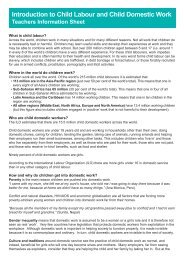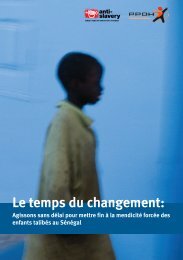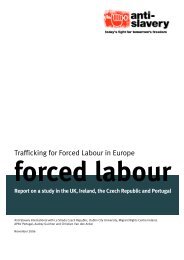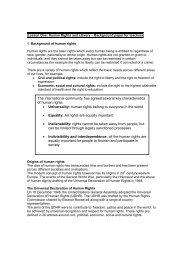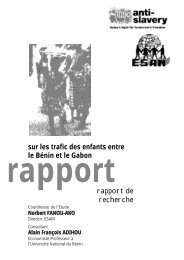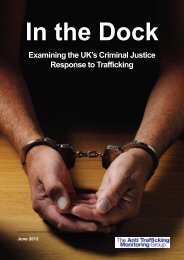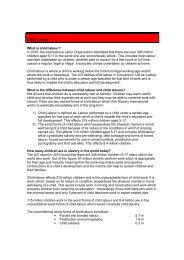Working with private partners - R v Jamali, Hagnegat, Bordbar and Gholampour<strong>In</strong>telligence from <strong>the</strong> public and business can be crucial where knowledge of child trafficking is lackingamong frontline officials. NGO initiatives, such as The Code, 371 and specialist trafficking police unitshave connected with private entities to raise awareness of trafficking, with a view to opening alterativechannels of intelligence ga<strong>the</strong>ring. One example of this can be found in R v Jamali, Hagnegat,Bordbar, and Gholampour, 372 which involved four Iranian nationals who attempted to sell <strong>the</strong> virginityof girls at <strong>the</strong> Jumeirah Carlton Hotel, in Knightsbridge, London. A handwritten letter was left at <strong>the</strong>hotel detailing <strong>the</strong> availability of 12 girls aged between 14 and 20 years. Hotel staff forwarded <strong>the</strong>letter to <strong>the</strong> MPS and a covert operation was initiated involving a Farsi-speaking police officer actingas a potential client. Communication was made with <strong>the</strong> group and photographs of <strong>the</strong> girls wereexchanged with <strong>the</strong> police before a meeting was arranged at a different hotel. When Jamali andHagnegat arrived with six girls <strong>the</strong>y were arrested. Owing to <strong>the</strong> vigilance of staff acting on priorawareness of child trafficking, <strong>the</strong>y were able to assist in intelligence ga<strong>the</strong>ring for this investigation.This case also highlights <strong>the</strong> need to use police from <strong>the</strong> same cultural background to effectivelyinfiltrate trafficking networks.At Harrow Crown Court all four pleaded guilty to conspiracy to traffick six women aged between 17and 22 years for sexual exploitation. Jamali and Hagnegat also admitted conspiracy to inciteprostitution for gain. The instigator, Jamali, was sentenced to two years and nine months. Hagnegat totwo years and six months, Bordbar to two years and three month, and Gholampour to two years andnine months. A charge of conspiracy to arrange child prostitution lies on <strong>the</strong> files of all four.The low sentences reflect <strong>the</strong> fact that <strong>the</strong> exploitation had not yet taken place. Although <strong>the</strong>photograph of a 14 year old to “entice” clients was viewed as an aggravating factor, <strong>the</strong> sentencingdoes not appear to have taken into account that one of <strong>the</strong> victims was only 17 years old. Article 24.bof <strong>the</strong> Convention states that child trafficking is considered an aggravating circumstance. This is alsoreflected in <strong>the</strong> sentencing guidelines issued by <strong>the</strong> Sentencing Council for England and Wales. 373This demonstrates that <strong>the</strong>re are still inconsistencies on <strong>the</strong> UK’s adherence to recognising <strong>the</strong>internationally agreed definition of a child.<strong>In</strong> November 2012, <strong>the</strong> Government stated that it was working in partnership with several agencies to“improve national and local understanding of <strong>the</strong> different local multi-agency models in place tosupport information sharing around safeguarding response for vulnerable people”, 374 which includedtrafficked children. However, <strong>the</strong> tried and tested Working Toge<strong>the</strong>r to Safeguard Children 375document coming into effect from 15 April 2013, has been reduced from 400 pages to 84, andremoves chapters on training and working with children in specific circumstances, such as sexualexploitation and trafficking. The ATMG believes that this will have a negative impact on multi-agencyworking. The proposed revision removes all reference to <strong>the</strong> investigation of organised or institutionalabuse. The Government should review this decision and acknowledge <strong>the</strong> success of Paladin andNewbridge which demonstrate <strong>the</strong> urgent need for multi-agency working on child trafficking. Delays tothis approach will continue to expose children to <strong>the</strong> risk of harm, re-trafficking and going missing fromcare, and, in turn, <strong>the</strong> likelihood of a successful prosecution.371The Code is an industry-driven, multi-stakeholder initiative with <strong>the</strong> mission to provide awareness, tools and support to <strong>the</strong> tourismindustry in order to combat <strong>the</strong> sexual exploitation of children in contexts related to travel and tourism. See: www.<strong>the</strong>code.org.372R v Jamali and o<strong>the</strong>rs at Harrow Crown Court, 10 September 2010.373GRETA, supra note 87.374Hansard, HC Deb, 13 November 2012, c129W.375Sentencing Guidelines Council, supra note 258.112
Child trafficking trainingThere is no mandatory training for frontline police who are often <strong>the</strong> first to come into contact withtrafficked children in criminal operation raids. For example, an interviewed law enforcement officerstated: “It’s very rare that an [officer in CID] is going to come across a victim directly, first time. It’sgoing to be a uniformed colleague or a PCSO or a station reception officer”. As a result children maybe treated as criminals instead of victims and not given <strong>the</strong> support or protection <strong>the</strong>y require. Also,<strong>the</strong> opportunity to investigate and ultimately prosecute cases of trafficking is <strong>the</strong>refore lost.Fur<strong>the</strong>rmore, <strong>the</strong>re is no mandatory training for social workers, health or education professionals onchild trafficking in <strong>the</strong> UK. There is, however, non-statutory guidance in Department of Education and<strong>the</strong> Home Office’s Safeguarding Children who may have been Trafficked. 376 This documentsupplements Working Toge<strong>the</strong>r to Safeguard Children. 377 This practice guidance is designed to helppractitioners who come into contact with children to identify and safeguard potential child victims oftrafficking. It states: “All practitioners who come into contact with children in <strong>the</strong>ir everyday work needto be able to recognise children who have been trafficked and be competent to act and support andprotect <strong>the</strong>se children from harm.” 378 <strong>In</strong> addition, <strong>the</strong> Government states: “Local authorities have aresponsibility to ensure that all staff working, or in contact with children and families participateregularly in relevant training tailored towards <strong>the</strong>ir individual roles. <strong>In</strong> addition, Local SafeguardingChildren Boards (LSCBs) should ensure that local training programs for practitioners and o<strong>the</strong>rprofessionals cover trafficking issues as appropriate.” 379 However, this wording is vague and gives noindication of how this training is to be provided, resourced, updated or evaluated in <strong>the</strong> context of <strong>the</strong>local authority’s response to child trafficking. Pockets of good practice do exist among local authoritiesin <strong>the</strong> UK, with some implementing and developing good practice guidance, as well as commissioningNGOs to train <strong>the</strong>ir staff annually.NGOs have helped plug this gap by providing specialist-training courses for those who come intoregular contact with children, such as social workers and police to equip <strong>the</strong>m to recognise indicatorsof trafficking and know how to respond. For example, ECPAT UK has provided training across <strong>the</strong> UKfor those working with children for over five years, offering introductory and advanced courses, as wellas more specialist training on Juju and witchcraft, investigating trafficking and providing safeaccommodation. However, despite NGOs trying to fill <strong>the</strong> void in training, <strong>the</strong> present situation isinadequate, and reduces <strong>the</strong> likelihood of successful police investigations and prosecutions. Whilstacknowledging that <strong>the</strong> police currently face budgetary cuts which are affecting <strong>the</strong>ir ability to providespecialist child trafficking training to all frontline staff, <strong>the</strong>re is a need for mandatory basic training forall police officers, so that <strong>the</strong>y can refer suspicions of trafficking to experienced “lead experts” in <strong>the</strong>force to investigate fur<strong>the</strong>r.Support and protection during criminal proceedingsEmerging from <strong>the</strong> research, one of <strong>the</strong> key influencing factors in an investigation and criminal trial is<strong>the</strong> protection and support of child victims whose needs are heightened during <strong>the</strong>se processes. Thesupport provided to child victims of trafficking in investigations and criminal proceedings was regardedby those interviewed as being <strong>the</strong> responsibility of <strong>the</strong> local authority. However, it is often <strong>the</strong> policeand/or social workers who provide support to trafficked children. A common problem cited is thattrafficked children are placed in inappropriate accommodation such as hotels and Bed & Breakfastsand inadequate safety procedures are in place which results in <strong>the</strong> continuance of children goingmissing from local authority care and possibly being re-trafficked. Where victims are under <strong>the</strong> controlof <strong>the</strong> trafficker, inappropriate placements increase <strong>the</strong> risk that a trafficked child will contact <strong>the</strong>376Department of Education, Safeguarding children who may have been trafficked - Practice guidance (October 2011).377HM Government, Working Toge<strong>the</strong>r to Safeguard Children. A Guide to <strong>In</strong>ter-Agency Working to Safeguard and Promote <strong>the</strong>Welfare of Children (Updated version published March 2010).378Department of Education, supra note 376, p.21.379Home Office, supra note 48, p.66.113
- Page 1 and 2:
In the DockExamining the UK’s Cri
- Page 3 and 4:
AcknowledgementsThis report was mad
- Page 5 and 6:
PrefaceIn May 2009, a group of nine
- Page 7 and 8:
Misconceptions around exploitation
- Page 9 and 10:
Acronyms and abbreviations frequent
- Page 11 and 12:
Executive SummaryIn the Dock is The
- Page 13 and 14:
Furthermore, the current legislatio
- Page 15 and 16:
The ATMG was made aware of some cas
- Page 17 and 18:
• Introduce mandatory child-speci
- Page 19 and 20:
• The UK’s ability to meet the
- Page 21 and 22:
Traffickers’ primary motivation i
- Page 23 and 24:
• Money launderers - turn profits
- Page 25 and 26:
out to perpetuate the exploitative
- Page 27 and 28:
[their] own enslavement” is as fu
- Page 29 and 30:
Chapter 2: UK Anti-Trafficking Legi
- Page 31 and 32:
nationals who commit trafficking of
- Page 33 and 34:
Like the SOA, the “act” element
- Page 35 and 36:
(b) D requires another person to pe
- Page 37 and 38:
Forced or compulsory labourThe defi
- Page 39 and 40:
ConclusionAs a consequence of the s
- Page 41 and 42:
concerningly, the number of convict
- Page 43 and 44:
women who were recruited in Poland
- Page 45 and 46:
Chapter 4: Identifying trafficking
- Page 47 and 48:
Misconceptions around exploitationT
- Page 49 and 50:
espond inadequately to a trafficked
- Page 51 and 52:
multi-agency teams was described by
- Page 53 and 54:
Josie Connors. 179 In summary, inte
- Page 55 and 56:
defending a trafficked person for f
- Page 57 and 58:
“[B]ecause the NRM decision is on
- Page 59 and 60:
PTSD. 196 A Consultant Psychiatrist
- Page 61 and 62:
etween the client and the police, i
- Page 63 and 64: Regular communication needs to be s
- Page 65 and 66: Priority planningA particular issue
- Page 67 and 68: Chapter 6: Multi-agency and interna
- Page 69 and 70: canvassing for tarmacking opportuni
- Page 71 and 72: Despite this, it would appear that
- Page 73 and 74: Good practice - Operation Golf 229O
- Page 75 and 76: Chapter 7: Criminal proceedingsThe
- Page 77 and 78: Law enforcement working on the case
- Page 79 and 80: trafficking require particular unde
- Page 81 and 82: JuryPractitioners suggested that th
- Page 83 and 84: years”. 258 Ambiguity within the
- Page 85 and 86: officer stated that not all judges
- Page 87 and 88: jurors to be assisted with expert e
- Page 89 and 90: Good feedback was received from sem
- Page 91 and 92: The Convention does recognise that
- Page 93 and 94: Another option for trafficked victi
- Page 95 and 96: There are two models with respect t
- Page 97 and 98: 1. Is there clear evidence that the
- Page 99 and 100: decision can be taken into account
- Page 101 and 102: also entails being “alert to the
- Page 103 and 104: In some cases concerns were even ra
- Page 105 and 106: Chapter 9: Prosecuting child traffi
- Page 107 and 108: However, many children are not refe
- Page 109 and 110: trafficking”. 352 It states: “W
- Page 111 and 112: Previous research has found that th
- Page 113: children as well as assisting in pr
- Page 117 and 118: were too traumatic to involve them
- Page 119 and 120: committed by a child whilst in a co
- Page 121 and 122: • Introduce mandatory child-speci
- Page 123 and 124: IdentificationThe PSNI is the main
- Page 125 and 126: participants suggest that this is b
- Page 127 and 128: The PPS stated that the reasons for
- Page 129 and 130: this research was aware of potentia
- Page 131 and 132: convictions of traffickers prosecut
- Page 133 and 134: Possibly in response to certain hur
- Page 135 and 136: espectively. In addition to custodi
- Page 137 and 138: Conclusion and RecommendationsThe A
- Page 139 and 140: CRIMINAL PROCEEDINGS• Ensure that
- Page 141 and 142: Crown Prosecution Service, Legal Gu
- Page 143 and 144: Herman. J. Trauma and Recovery: The
- Page 145 and 146: Annex I: Trafficking and other form
- Page 147 and 148: (a) on summary conviction, to impri
- Page 149 and 150: (b) which country is the country of
- Page 151 and 152: 2009 Istvan Kalocsai (Snr)MetS.57 o
- Page 153 and 154: 2009 causing actual bodily harm, su
- Page 155 and 156: Skirmantas Kvedaras Feed, 2010 Rape
- Page 157 and 158: 2012 Ahdel Ali (24)Mubarek Ali (29)
- Page 159 and 160: Annex III: The CPS’s Seven Stages
- Page 161 and 162: 159


